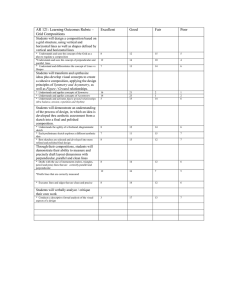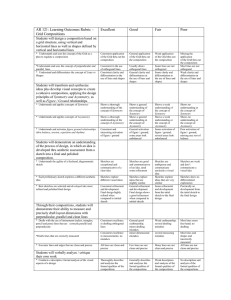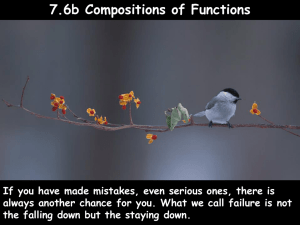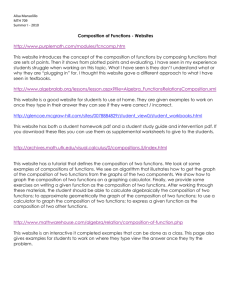Course AR 121
advertisement
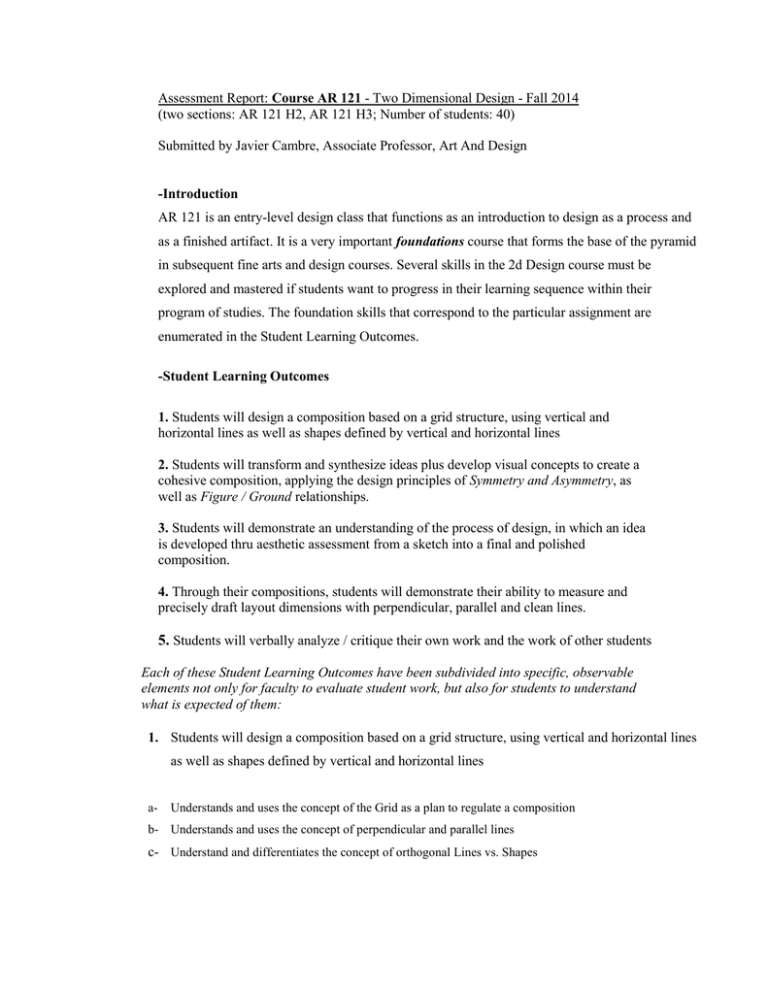
Assessment Report: Course AR 121 - Two Dimensional Design - Fall 2014 (two sections: AR 121 H2, AR 121 H3; Number of students: 40) Submitted by Javier Cambre, Associate Professor, Art And Design -Introduction AR 121 is an entry-level design class that functions as an introduction to design as a process and as a finished artifact. It is a very important foundations course that forms the base of the pyramid in subsequent fine arts and design courses. Several skills in the 2d Design course must be explored and mastered if students want to progress in their learning sequence within their program of studies. The foundation skills that correspond to the particular assignment are enumerated in the Student Learning Outcomes. -Student Learning Outcomes 1. Students will design a composition based on a grid structure, using vertical and horizontal lines as well as shapes defined by vertical and horizontal lines 2. Students will transform and synthesize ideas plus develop visual concepts to create a cohesive composition, applying the design principles of Symmetry and Asymmetry, as well as Figure / Ground relationships. 3. Students will demonstrate an understanding of the process of design, in which an idea is developed thru aesthetic assessment from a sketch into a final and polished composition. 4. Through their compositions, students will demonstrate their ability to measure and precisely draft layout dimensions with perpendicular, parallel and clean lines. 5. Students will verbally analyze / critique their own work and the work of other students Each of these Student Learning Outcomes have been subdivided into specific, observable elements not only for faculty to evaluate student work, but also for students to understand what is expected of them: 1. Students will design a composition based on a grid structure, using vertical and horizontal lines as well as shapes defined by vertical and horizontal lines a- Understands and uses the concept of the Grid as a plan to regulate a composition b- Understands and uses the concept of perpendicular and parallel lines c- Understand and differentiates the concept of orthogonal Lines vs. Shapes 2. Students will transform and synthesize ideas plus develop visual concepts to create a cohesive composition, applying the design principles of Symmetry and Asymmetry, as well as Figure / Ground relationships. a- Understands and applies concepts of Symmetry b- Understands and applies concepts of Asymmetry c- Understands and activates figure ground relationships (thru balance, tension, repetition and rhythm) 3. Students will demonstrate an understanding of the process of design, in which an idea is developed thru aesthetic assessment from a sketch into a final and polished composition. a- Understands and executes with agility the concept of a freehand, diagrammatic sketch b- Each preliminary sketch explores a different aesthetic idea c- Best sketches are selected and developed into more refined and polished final designs 4. Through their compositions, students will demonstrate their ability to measure and precisely draft layout dimensions with perpendicular, parallel and clean lines. a- Drafts with the use of instruments (rulers, triangles, pencil and pens) lines that are correctly parallel and perpendicular b- Drafts lines that are correctly measured c.- Executes lines and edges that are clean and precise 5. Students will verbally analyze / critique their own work and the work of other students a- Conducts a descriptive formal analysis of the visual aspects of a design b- Proper use of art terminology -General Educational Outcomes 1 -Students apply aesthetic and intellectual criteria by identifying and evaluating visual on an established or newly created work of art cues 2- Students will use the proper lexicon to their discipline to appropriately discuss the work. 3- Reason quantitatively and mathematically as required in their fields of interest and in everyday life 4- Integrate knowledge and skills in their program of study 5- Use information management and technology skills effectively for academic research and life long learning -Description of Assignment You are asked to create two compositions, focusing on concepts of: -Symmetry and Asymmetry, -Figure / Ground Relationships (based on tension, balance, repetition, variation and rhythm) -Grid Structures, -Drafting and Measuring 1) Sketch 6 compositions (medium-pencil # HB). a) Draw 6 squares (3"x 3") b) On each of the squares create your own grid systems using vertical and horizontal lines: (3 sketches for symmetry and 3 sketches for asymmetry) c) Select some lines and areas within your grid compositions and proceed to render them in black (establish balanced and interesting figure/ground relationships) d) Assess and develop the sketches into final designs 2) Final Compositions On one page of bristol paper you will position two designs, one for symmetry and one for asymmetry. a) Select two compositions from your sketches (one symmetric and one asymmetric) and proceed to render the final design on a page of bristol. b) From the compositions selected from the sketches, assign positive and negative values to sections of the grid, so you know which portions of the design will correspond to the filled-in areas (figure) and which will correspond to the white of the paper (ground) Evidence Each student submitted two design compositions, one for a Symmetric Grid and one for an Asymmetric grid. These compositions were evaluated using the Rubric developed for my assessment plan during the Assessment Institute in Fall 2014. Analysis and Summary The scoring of each composition has been tallied in the attached rubric. The first Student Learning Outcome: “Students will design a composition based on a grid structure, using vertical and horizontal lines as well as shapes defined by vertical and horizontal lines” was subdivided into three measurable categories: 1) the concept of the Grid, 2) the concept of parallel and perpendicular lines 3) The concepts of lines vs. shapes. Under these subcategories students scored higher in terms of conceptualizing orthogonality (Parallel and Perpendicular elements) and just a little lower in terms of conceptualizing the Grid and the relation of lines and shapes. Future improvements could be achieved by presenting more in depth examples of grid structures and their application in design and works of arts. Under the second SLO, “Students will transform and synthesize ideas plus develop visual concepts to create a cohesive composition, applying the design principles of Symmetry and Asymmetry, as well as Figure / Ground relationships” students performed extremely well in the first two measurable subcategories 1) Symmetry and 2) Asymmetry and slightly lower in achieving 3) Figure - ground relationships. The concept of figure /ground is probably the most important concept in the whole course and it is recurrently explored in most exercises in AR121. It is a complex concept for students to grasp and more examples plus further exercises should reinforce its understanding. The following SLO : “Students will demonstrate an understanding of the process of design, in which an idea is developed thru aesthetic assessment from a sketch into a final and polished composition.” provided similar scoring across the board under its 3 measurable subcategories. More or less half of the class performs under Good or Excellent and half of the class is Fair or Poor. Around 19% scored “excellent” and around 18% scored “poor”. Future improvements could be achieved by reinforcing the guidelines in the exercise in terms of clarification of sketch development thru examples, as well as open discussions. The next SLO: “Through their compositions, students will demonstrate their ability to measure and precisely draft layout dimensions with perpendicular, parallel and clean lines” surprisingly shows that more or less half of the students struggle in some aspect with simple, mechanical hands-on tasks such as drafting and measuring with a ruler. On one level, one explanation resides in the fact that our program is filled thru an “open enrollment” policy: there is no portfolio review for students to enter our Art and Design programs. While scoring this rubric I came to realize that both sections that were part of this assessment have more or less 15% of students with a declared learning disability. Some of these students struggle the whole semester with basic skills such as using a simple ruler or struggle with drafting a clean and precise perpendicular line. Constantly helping and instructing such students in these hands–on tasks is a difficult challenge for a professor trying to teach a college level class. Further dialogue with my colleagues at the art department should address ways to assess this issue. Scoring the last SLO: “Students will verbally analyze / critique their own work- Conducting a descriptive formal analysis of the visual aspects of a design” demonstrated that only a few of the students are capable of communicating verbally using the correct “art and design” vocabulary. Reinforcement of this SLO could be improved in conjunction with Art History professors and by extending the range of theory in studio classes. Assessment Results Basically and in general terms, students scored in similar percentage within the different SLO’s with the exception of the last SLO, concerning verbal communication. This clearly shows that the students need further support in this area. This can be reinforced thru dialogue with Art history professors and by incorporating more theory in the Studio classes. Students need to be encouraged and guided in the importance of the verbal communication of art and design ideas as well as its corresponding terminology. The low scoring of some students in simple, hands-on tasks such as drafting and measuring with a ruler, sometimes related to students with learning disabilities is an ongoing issue that should be assessed with my colleagues in the Art Dept. On the other hand, our more gifted and dedicated students always surprise me with the ingenuity of their design compositions.
